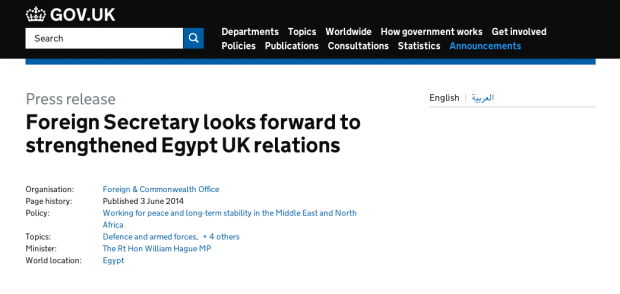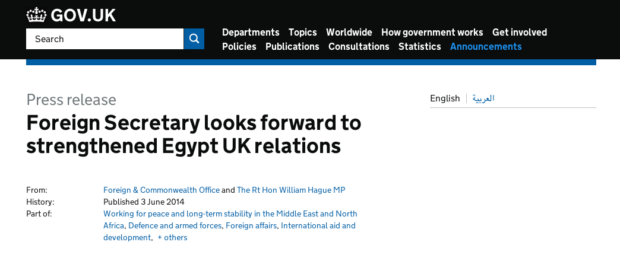We're changing the metadata labels across the Departments and Policy section of GOV.UK to make browsing simpler and more intuitive.
Many new labels have been added in the last couple of years. What started out as easy to follow has become a lot harder for some users. Sectors, topics, policies, collections, organisations... it can be confusing.
So we're trying out a simple solution and it'd be good to know what you think.
Before and after the changes
Up until now, Department and Policy pages have shown the organisation, policy, topics, minister and world location as separate labels.

Here's what we're trying instead. In this new model, pages are 'from' organisations, people or groups. They're 'part of' policies, topics, collections and other subject based metadata. History remains as a separate line and we'll continue to use 'applies to' for content that covers specific parts of the UK.

The ordering of items within a label is based on what users click now. Organisations are clicked on most, followed by document collections, policies, sectors and worldwide organisations. Topics and people's names are clicked on least, so they're currently listed at the end.
We know that the word 'from' isn't perfect, but it's very easy to change. If your organisation either leads on or supports a particular issue then please continue to mark it as such.
Next steps
We'll be able to continue the new metadata patterns across many GOV.UK pages, so it ought to be easier for users to click around and find what they need. If people like them, we'll look at rolling them out to pages that don't currently carry metadata - the result will hopefully be a consistent and simple way to navigate from one end of GOV.UK to the other.
We'll also add translated versions for 'part of' and 'from' so users looking at foreign language versions of our pages can find their way around.
As with every part of GOV.UK, we'll listen intently to user feedback and keep an eye on the stats. It's easy to iterate these patterns and we expect to keep on making tweaks. If you have any comments please do post below.
Keep in touch. Sign up to email updates from this blog, or follow Will on Twitter.
6 comments
Comment by Andrew Robertson posted on
Thanks for offering the chance to comment.
I question whether altering the display of metadata fields really will be simpler and clearer: it feels that we’re moving from labelled links to a potentially very long list of what appears to be random links. I say random, because there is little consistency in how topics, policies, collections etc are labelled so I do wonder if people will randomly click, or just feel overwhelmed and not bother clicking?
You didn't mention how the metadata at the bottom of the page will be displayed? If that continues to be separate, a merged list at the top might not matter.
I welcome consistency in the use of metadata. For example topics are displayed on press release pages but not publication pages.
Collections are a way of grouping very similar stuff together and may help people complete a task more easily. Do you think merging the collection link amongst high-level topics and government priorities and names of ministers is a sensible move? I don’t have the evidence, but my assumption is most users want to find related guidance or forms ahead of how this fits into government policy. I wonder if it would be better to label collections separately?
Great to hear this can be changed quickly, so I’ll wait to be proved wrong with customer feedback and data!
Comment by Michael Williams posted on
This needs doing and you’ve made a good start – but I wonder if ‘From’ and ‘Part of’ oversimplify the relationships they describe?
Not all content related to an organisation is ‘from’ it. Take independent bodies like the Social Security Advisory Committee (SSAC). We indicate the relationship between their independent reports and DWP by listing the department as a supporting organisation. We need to show this relationship without compromising SSAC’s independence – and ‘From DWP’ could do so. And although SSAC reports may be related to a government policy, they’re not ‘part of’ it, with the cosiness that implies. Perhaps ‘About’ would work for policy relationships?
Neither the old nor new labels distinguish between lead and supporting organisations. Perhaps you could include ‘(lead)’ where appropriate.
It’s not clear from your example what you plan for collections. I don’t think grouping them with ‘Part of’ would do justice to their importance. I’d try a separate ‘More like this’ label.
I know ‘Related to’ is vague and could take the place of any of the labels but I’d try it for organisations if you continue to list lead and supporting ones together. 'From' would do for lead organisations if you show them separately.
You could show just the main metadata and hide the rest behind ‘More’ or a similar link – with sensible exceptions like always showing ‘People’ for speeches. So show these:
● From – lead organisation(s) only)
● More like this – collection
● About – policy
Labels are a compromise between accuracy and brevity – so you could try linking them to a pop-out explanation (a bit like ‘see all updates’).
Comment by Will Callaghan posted on
Thanks for your comments both and apologies for the delay in replying.
We totally agree that any label is a compromise and will be keeping an eye on the data to see what users make of them. I'll share the idea about 'pop out explanations' - thanks for suggesting it.
Collections had the highest click through rate before we made these changes so we'll be looking to see if this continues. They're one of the main ways users navigate so we don't want to do anything to harm that.
On lead vs supporting orgs, lead orgs are listed first in the new pattern and supporting orgs are often last or placed under a '+others' link. We're not sure users will understand the difference between leading and supporting, but will keep an eye on this too.
Comment by E. Brown posted on
Hi Will,
I appreciate that GDS is trying to minimise the clutter of metadata on pages. But I think throwing policies and collections together is a poor choice, and will not help.
Personally I relied on seeing the policies and the collections separate. We use a lot of collections, and only refer to a few policies - so using policies as a 'filter' or search tool for related content isn't very useful.
I know the 'anecdote is not data', and you won't make a decision simply on verbal feedback. So how long a period do you need before you decide you've made a mistake and return to a previous iteration that was better?
Comment by Will Callaghan posted on
Hi Liz, it's not a question of 'how long we need', rather what feedback we get - from this blog post, analytics and comments from users.
Posts like yours are really helpful so thanks for taking the time.
Comment by simonfj posted on
Hi Will,
I think we have a problem here which is caused by the lack of consistency in how "groups" are treated.
We know that, as a category, Groups is being used to gather similar orgs. i.e.
".. with the arrival of agencies and arms length bodies we need to model a much wider range of groups: panels, committees, auditors, monitors, steering groups, programme boards, councils and units – to name just a few". https://insidegovuk.blog.gov.uk/2014/04/03/your-new-favourite-group/
And the confusion still remains. Just compare https://www.gov.uk/government/groups
to the 339 "Agencies and other public bodies" on this list. https://www.gov.uk/government/organisations
So you'll firstly need to take a consistent approach to how these orgs/groups are treated.
It's a tricky one, cause "leading org" can always be considered a "group" or "person" FROM inside an org. Maybe we're coming down to the stage where any doc will be attributed to a group - sometimes "From" an organisation, "In collaboration with" other groups.
I suppose you don't have a couple of good (digital) librarians around your place do you? They'd straighten this out quick fast.